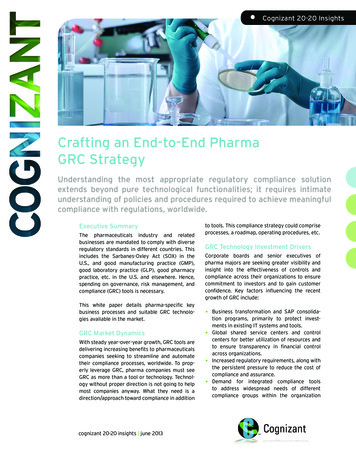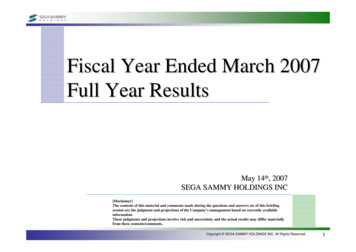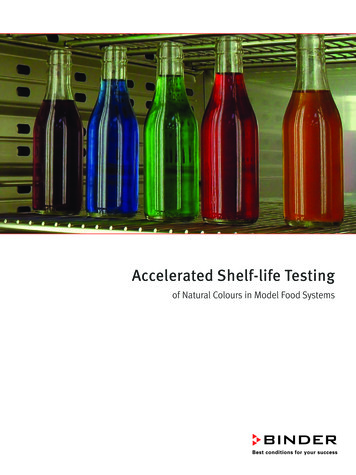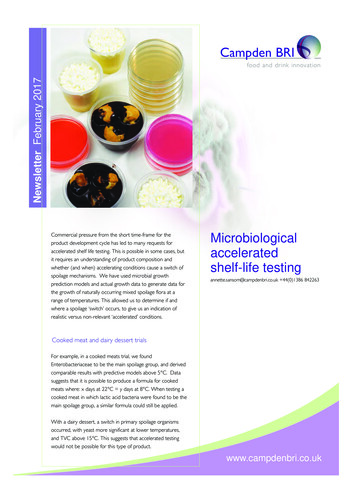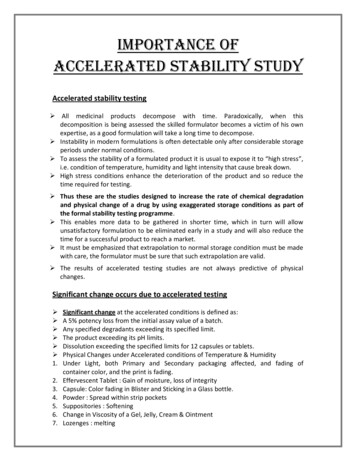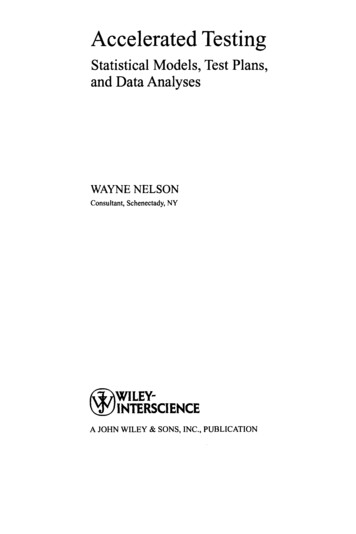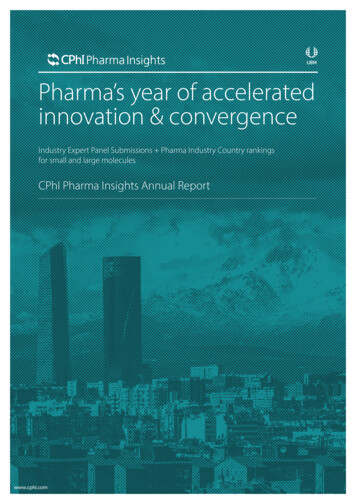
Transcription
Pharma’s year of acceleratedinnovation & convergenceIndustry Expert Panel Submissions Pharma Industry Country rankingsfor small and large moleculesCPhI Pharma Insights Annual Reportwww.cphi.com
The CPhI Annual Report is a comprehensive and critically important publicationthat analyses key trends and innovations forecast by our panel of world classexperts. Running as a series of opinions and articles, the CPhI experts call upon theirconsiderable commercial and technical acumen to prophesize the future direction,technologies, opportunities and threats in pharma. It’s an essential read for executiveswho wish to get a head start today on the shape of tomorrow’s industry.ContentsForeword. . . . . . . . . . . . . . . . . . . . . . . . . . . . . . . . . . . . . . . . . . . . . . . . . . . . . . . . . . . . . . . . . . . . . . . . . . . . . . . . . . . . . . . . . . . . . . . . . . . . . . . . . . . . . . . . . . . . . . . . . . . . . . . . . . . . . . . . . . . . . . . . . . . . . . . . . . . . . . . . . . . . . . . . . . . . . . . . . . . . . . . . . . . . . . . . 4BY ORHAN CAGLAYAN & RUTGER OUDEJANSCPhI’s Pharma Industry Rankings: a snapshot of pharma’s health. . . . . . . . . . . . . . . . . . . . . . . . . . . . . . . . . . . . . . . . . . . . . . . . . . . . . . . . . . . . . . . . . . . . . . . . . . . . . . . . 5Part 1. Preventing innovation inertiaPharma’s future is putting innovations in the hands of innovators. . . . . . . . . . . . . . . . . . . . . . . . . . . . . . . . . . . . . . . . . . . . . . . . . . . . . . . . . . . . . . . . . . . . . . . . . . . . . . . . . 19GIRISH MALHOTRA PRESIDENT AT EPCOT INTERNATIONALPart 2. The impact of global regulation, data integrity and convergenceWIPRs in Trade Agreements & Access to Medicines. . . . . . . . . . . . . . . . . . . . . . . . . . . . . . . . . . . . . . . . . . . . . . . . . . . . . . . . . . . . . . . . . . . . . . . . . . . . . . . . . . . . . . . . . . . . . . . . . . . . . . . . . . . . . . . 25DILIP SHAH, CEO AT VISION CONSULTING GROUPTechnology and Innovation Gap Converges Over the Next Decade. . . . . . . . . . . . . . . . . . . . . . . . . . . . . . . . . . . . . . . . . . . . . . . . . . . . . . . . . . . . . . . . . . . . . . . . . . . . . . . 29BIKASH CHATTERJEE, PRESIDENT AND CHIEF SCIENCE OFFICER, PHARMATECH ASSOCIATESGreat Expectations: Pharma vs Excipient Data Integrity. . . . . . . . . . . . . . . . . . . . . . . . . . . . . . . . . . . . . . . . . . . . . . . . . . . . . . . . . . . . . . . . . . . . . . . . . . . . . . . . . . . . . . . . . . . . . . . . . . . . . . 34BRIAN CARLIN, DIRECTOR QBD/REGULATORY DFE PHARMADALE CARTER, HEAD OF QUALITY SILICA AMERICAS EVONIKIRWIN SILVERSTEIN, PRESIDENT, IBS CONSULTING IN QUALITY LLCANN GULAU, QUALITY ASSURANCE, DOW CHEMICAL COMPANYBRITTNEY WELLS, REGULATORY LEAD, CQA, CQE, PCQI, LONZAKATHERINE ULMAN, PRIMARY AT KLU CONSULTING.Part 3. Opportunities and threats from continuous processing and opioid quotasContinuous Manufacturing: What is not Happening and Why. . . . . . . . . . . . . . . . . . . . . . . . . . . . . . . . . . . . . . . . . . . . . . . . . . . . . . . . . . . . . . . . . . . . . . . . . . . . . . . . . . . . . . . . . . 42EMIL W. CIURCZAK, DORAMAXX CONSULTINGControlled Substances in 2018: The Contract Manufacturing Industry. . . . . . . . . . . . . . . . . . . . . . . . . . . . . . . . . . . . . . . . . . . . . . . . . . . . . . . . . . . . . . . . . . . . . . . . . . 47FIONA BARRY EDITOR, PHARMSOURCE, A GLOBALDATA PRODUCTADAM BRADBURY INDUSTRY ANALYST, PHARMSOURCE, A GLOBALDATA PRODUCTCPhI Pharma Insights Annual Report: Expert Contribution2October 2018, Madrid Produced by Defacto
Part 4. The rise of the integrated CDMO and ‘ADCs the intersection of small and large’ADCs growth driven by lack of inhouse facilities, oncology and integrated CDMOs. . . . . . . . . . . . . . . . . . . . . . . . . . . . . . . . . . . . . . . . . . . . . . . 53VIVEK SHARMA, CEO PIRAMAL PHARMA SOLUTIONS.‘Pharma’s golden age’ needs geographically integrated CDMOs to sustain pipeline growth. . . . . . . . . . . . . . . . . . . . . . . . . . . . . . . 60MINZHANG CHEN, PH.D. CEO OF STA PHARMACEUTICAL, A WUXI APPTEC COMPANY (WUXI STA)Part 5. The bioLIVE biologicals predications and trends– processing advancements, capacity changes and cross industry learnings’Supply and Demand Trends: Mammalian Biomanufacturing Industry Overview. . . . . . . . . . . . . . . . . . . . . . . . . . . . . . . . . . . . . . . . . . . . . . . . . . . . . 64DAWN M. ECKER CONSULTANT & BIOTRAK DATABASE MANAGER, BIOPROCESS TECHNOLOGY CONSULTANTSPATRICIA SEYMOUR, PRINCIPAL CONSULTANT, BIOPROCESS TECHNOLOGY CONSULTANTSTop Bioprocessing Trends for the Next Five Years. . . . . . . . . . . . . . . . . . . . . . . . . . . . . . . . . . . . . . . . . . . . . . . . . . . . . . . . . . . . . . . . . . . . . . . . . . . . . . . . . . . . . . . . . . . . . . . . . . . . . . . . . . . . . . . . . . 72MICHIEL E. ULTEE, PHD, ULTEEMIT BIOCONSULTING, LLCThe Intersection of Small Pharma and BioPharma. . . . . . . . . . . . . . . . . . . . . . . . . . . . . . . . . . . . . . . . . . . . . . . . . . . . . . . . . . . . . . . . . . . . . . . . . . . . . . . . . . . . . . . . . . . . . . . . . . . . . . . . . . . . . . . . 76KENT PAYNE, CEO, SOCORRO PHARMACEUTICALS, LLCCPhI Pharma Insights Annual Report: Expert Contribution3October 2018, Madrid Produced by Defacto
Welcome to the CPhI Pharma InsightsAnnual ReportForeword by Orhan CaglayanIt has been a particularly successful 12-months for our industry. We’ve seen a truly stellar performance from the R&Dcommunity, with a record 46 FDA approvals in 2017 and 40 more already in 2018. There are in fact now more productsin development than at any other point in history – with 15,000 in the pipeline. It would not be too bold a claim to saywe are entering a ‘golden age’ of pharma innovation. But as an industry, we can also take great pride in the developmentswe are seeing across the board – not only in the commercialisation of novel therapies, but in improved techniquesand renewed strategies to carrying out pharma manufacturing. We have seen huge innovation in terms of processimprovements, whilst advances in flow chemistry, AI and 3D dosage printing are reducing prices and developmenttimelines and increasing patient access. What’s more exciting is that innovation is not only being driven by dictatesfrom regulators, but is being created from the ground-up by all types of companies, coming from talented CDMOs,API manufacturers, formulation specialists and generics producers. The industry is, of course, also moving towards largemolecules and in response we have launched bioLIVE – our new bioprocessing and manufacturing exhibition, which runsadjacent to CPhI Worldwide. It arrives at a particularly prominent moment, as in the last year we have seen a proliferationof biosimilars and double-digit approvals of biologics – as well as a whole host of investments taking place in contractservices. Not to mention ground-breaking innovations, as the EMA approved two gene therapies – Yascarta and Alofise– with a further 1000 gene therapy products and 600 CAR-T assets under development. In such a dynamic time forthe industry, access to insights and analysis are integral to any companies future growth potential and we encourageall pharma professionals to study the CPhI Annual Report closely – both the pharma league tables and our expertcontributions. The next year promises huge opportunities and developments.Orhan CaglayanBrand DirectorCPhI Pharma Insights Annual Report: Expert Contribution4October 2018, Madrid Produced by Defacto
CPhI’s Pharma Industry Rankings:a snapshot of pharma’s healthReputation matters in a rapidly changing global marketand CPhI Worldwide has again surveyed more than 350of the world’s leading pharmaceutical companies andexecutives to rank the reputations of the most prominentpharma countries. Investment decisions and supply-sidearrangements can often hinge on this unspoken influence,particularly when working with new partners. As theworld’s largest pharma event, with over 45,000 attendeesand 150 countries represented, CPhI provides you with adirect window of evidence and analysis on global pharma’soverall health. Thanks to our unrivalled industry reach,our survey identifies all the major trends, changes, anddevelopments alongside a ‘health-check’ on the reputationof each major pharmaceutical economy. The results, asyou’ll see, include country-specific rankings based onkey indicators such as active pharmaceutical ingredient(API) production, innovativeness, market competitiveness,and finished dosage formulations. To celebrate theexciting launch of bioLIVE, our new bioprocessing andbiomanufacturing event, this year’s anlaysis also exploresthe ability of countries to meet future bio capacity needs,alongside rankings for bio- innovation and manufacturingquality.Pharma Market Growth PotentialUnsurprisingly, India (7.16), USA (7.04) and China (6.81) areagain the countries executives highlighted as having thefastest growth potential. Respondents cited their highgrowth domestic markets and expanding manufacturingexports as the key drivers. The U.S., which has seen aresurgence in the past year, was understandably strong,while Germany was seen as Europe’s key growth market.It was notably well clear of France, Spain, the U.K., andItaly. The biggest movers in terms of growth potentialin comparison to last year were the United Kingdom,boosting its score by 12.72%, followed by the Italy( 10.94%), USA ( 10.63%) and Japan ( 9.56%). The bigsurprise was views of China’s growth potential decreasingby 5.34%. This may reflect ongoing trade issues with theUS, which is, of course, by far the world’s biggest pharmamarket.Figure 1: Ranking of countries according to their predicted pharma market growthCPhI Pharma Insights Annual Report: Expert Contribution5October 2018, Madrid Produced by Defacto
Pharmaceutical API ManufacturingPharma professionals were asked to rank the qualityof pharmaceutical API manufacturing. Germany (7.81)claimed top spot, followed closely by Japan (7.78) andthe U.S. (7.55). The research also shows that there is asecond tier reputation-wise of well-regarded markets.France and the U.K head this group with Italy just behind.Interestingly, India’s recent reputation building effortsmay be paying dividends, as its API manufacturing is nowseen to be broadly comparable to that of Italy, Spain, andKorea. Italy lead the way in quality of pharmaceutical APImanufacturing improvement up 13.54% on last year. China( 10.79%), India ( 9.56%) and Korea ( 8.91%) round up thetop four.Figure 2: Ranking of countries according to their quality of pharmaceutical API manufacturingInnovativeness in Small MoleculeInnovation activities are vital for new medicines and theU.S. (7.93) is again the highest-ranking country in thissector. Japan (7.49) comes in second, owing to its historicpatent-centric drugs market, excellent reimbursment,and a large number of innovative pharma companies.Germany and the U.K. also scored extremely well. Spain,CPhI Pharma Insights Annual Report: Expert Contributionhost of CPhI Worldwide in 2018, was the big mover with a16.38% increase in comparison to last year. The continuingevolution of the biotech industry in Madrid and Barcelonaseems likely to be having positive effects. Italy ( 10.80%),India ( 10.02%) and France ( 8.12%) completed the topfour sector movers.6October 2018, Madrid Produced by Defacto
Figure 3: Ranking of countries according to their innovativeness in the pharma industryCompetitivenessTo guage overall competitiveness respondents were askedto evaluate cumulatively each country’s tax environment,quality of employees, infrastructure, research potential,labor costs, accessibility, and access to funds. The U.S. (6.98)again topped the pile ahead of Germany (6.56). A strongsecond tier of countries included India, China, and themore mature economies of Japan, France, and the U.K.Korea also featured prominently because its mix of overallgrowth and expanding biologics sector. Korea (6.21%) tooled the way in improvement on 2017 followed by Italy(6.02%), France (5.50%) and Japan (5.44%).Figure 4: Ranking of countries according to their overall competitivenessCPhI Pharma Insights Annual Report: Expert Contribution7October 2018, Madrid Produced by Defacto
Pharmaceutical Finished Product ManufacturingMirroring 2017, Germany (8.07), the U.S. (8.01) and Japan(7.95) are again above all other major pharma economiesin terms of the quality of finished formulations driven bythe strong standing of their manufacturers and regulators.The second tier includes the U.K., France, and Italy, whileIndia and China were regarded as having lower-qualityfinished products. The latter’s comparable status to India issomewhat surprising given India’s more substantial finishedproduct industry. India leads the way in growth improvingby 14.72%, but it was closely followed by China, whichsaw its score increase by 13.74%. Italy (11.90%) and Korea(8.88%) complete the top 4 movers. These findings indicatea a wider trend of perceptions around quality gradualyharmonising as India and China climb to western standards.Figure 5: Ranking of countries according to the quality of finished product manufacturingCountry Reputational RankingThe overall reputation rank of each country is based on anaverage score across all five categories. The U.S. (7.50) onceagain claimed first place, thanks to its strong performancesacross multiple categories. Germany (7.21) and Japan (7.19)followed closely behind. China fagain finished bottomdespite leading the growth potential category.Figure 6: Overall reputation rank of each countryCPhI Pharma Insights Annual Report: Expert Contribution8October 2018, Madrid Produced by Defacto
As shown in figure 7, India (10.92%) and China have bothmade huge strides improving the perceptions with animpressive 9.64% increase in overall score on 2017. Thisreflects probably an easing of negative news around Indianmanufacturing, and China’s considerable efforts to impovequality over the last year. In particular, the commitment toharmonise standards with The International Committeeof Harmonization (ICH) has been a huge catalyst forimproving quality all across the country.“China is issuing new guidelines at afeverish pace and will be harmonised withICH very quickly. The result is that overthe next two to three years poorer qalitymanufacturers will drop out of the marketand China’s manufacturers will look tocompete in international markets as wellas domestic” CPhI Annual Report Expert,Bikash ChatterjeeKorea’s overall reputation went up by 5.71% due to itsmixture of growth and expanding of their biologics sector.The top tier countries saw much more modest gains andGermany’s fortunes suffered a notable decline.Figure 7: Percentage annual change in overall reputation rank of each countryCountry Bio Processing and Manufacturing Knowledge of Biologics ProfessionalsThe U.S. (8.03), Germany (7.79) and Japan (7.65) score thehighest for the knowledge of their biologics professionals.The second tier includes the U.K. (7.36), France (7.23) andIreland (7.16). Ireland’s high score in this category can beexplained, in part, by new training initiatives brought inby Ireland’s National Institute for Bioprocessing ResearchCPhI Pharma Insights Annual Report: Expert Contribution(NIBRT). China (6.12) and India (6.46) were ranked last andsecond last reflecting the immaturity of their respectiveindustries. China in particular is experiencing high demandfor biologics professionals as its industry continues to growquickly.9October 2018, Madrid Produced by Defacto
Figure 8: Ranking of countries according to the knowledge of their biologics professionals.Ability to Meet Future Bio Capacity RequirementsThe U.S. (7.87), Germany (7.67), Sweden (7.63), Japan (7.48)led the standings among respondents in terms of theirability to meet future capacity requirements. Below thesetier one nations, scores were broadly comparable; fromKorea (6.78) to Spain (6.35) at the bottom. These results areinteresting as there have been a number of investmentsmade from big pharma and CDMOs, particularly those inAsia in recent years. For example, Sanofi plans to investaround 600 million euros annually for the next few years,BI’s 230m development centre, the 240m in capital byWuXi Biologics for a new biologics centre in NorthernChina, and Samsung BioLogics’ recently completed 740m facility in South Korea. Yet, despite the latter twoinvestments, China and Korea scored relatively low. Thissuggests either perception lacks behind reality, or a beliefthat demand will increase even faster than the facilitiescan be completed and/or that there is an existing need forgreater capacity in these countries.Interestingly, The U.S. trails Asia in terms of investment, butstill ranked the highest in this category, suggesting thatrespondents believe that The U.S. already has a surplusof capacity to deal with both current and future industrydemands.Figure 9: Ranking of countries according to their ability to meet future capacity requirements.CPhI Pharma Insights Annual Report: Expert Contribution10October 2018, Madrid Produced by Defacto
Innovativeness of Biologics industry and Quality of Biological ProcessingFor innovativeness of biologics industry, The U.S. (7.95),Japan (7.62) and Germany (7.37) were, once again, thehighest scorers, while China (5.82) and India (6.00) were thelowest. This mirrors their rankings in small molecules forpercepetion of pharma innovation.whereas China and India are still developing. Dawn M.Ecker of BioProcess Technology Consultants and bioLIVEexpert commented: “If we look at quality and innovation– both important attributes for advancing bioprocessingtechnologies – the US, Germany and Japan are rankedhighest, followed by several other European countries,where biomanufacturing is a mature industry. China andIndia, both burgeoning markets for biologics, were notranked as high for innovation. This perception may relate tothe still developing biologics and bioprocessing industry inthese regions, coupled with the knowledge of their existingreputations for mass production of generics.”For quality of biological processing, The U.S. (8.01) rankedhighest, closely followed by Japan (7.72) and Germany(7.59), with European countries largely making up thesecond tier. China (5.61) and India (6.02) finished bottom ofthe table.These results reflect the fact that The U.S., Japan andGermany all have established biomanufacturing industriesFigure 10: Ranking of countries according to innovativeness of their biologics industry.CPhI Pharma Insights Annual Report: Expert Contribution11October 2018, Madrid Produced by Defacto
Figure 11: Ranking of countries according to the quality of their biological processing.Growth Potential of Biologics Manufacturing IndustryThe U.S. saw the highest score for growth potential forbiologics manufacturing industry. The most interestingresult in this category was Ireland (7.30), which was rankedthird, placing it above Germany (7.23). The envisagedaddition of significant new capacity in biomanufacturingfacilities is likely to be a key driver; e.g. WuXi Biologicsrecently committed to a 325 investment to create theworld’s largest biomanufacturing facility using single-usebioreactors here. Singapore (6.38) and The U.K. (6.40) wereranked the lowest by respondents in terms of their growthpotential. It has been suggested that perception couldbe lagging behind reality as many of the Asian countries,such as Singapore and China, performed poorly in spiteCPhI Pharma Insights Annual Report: Expert Contributionof their rapid development as bio hubs. These nationshave a lot more capacity for potential growth comparedto countries with mature and well established biologicsmanufacturing industries like The
dawn m. ecker consultant & biotrak database manager, bioprocess technology consultants patricia seymour, principal consultant, bioprocess technology consultants top
